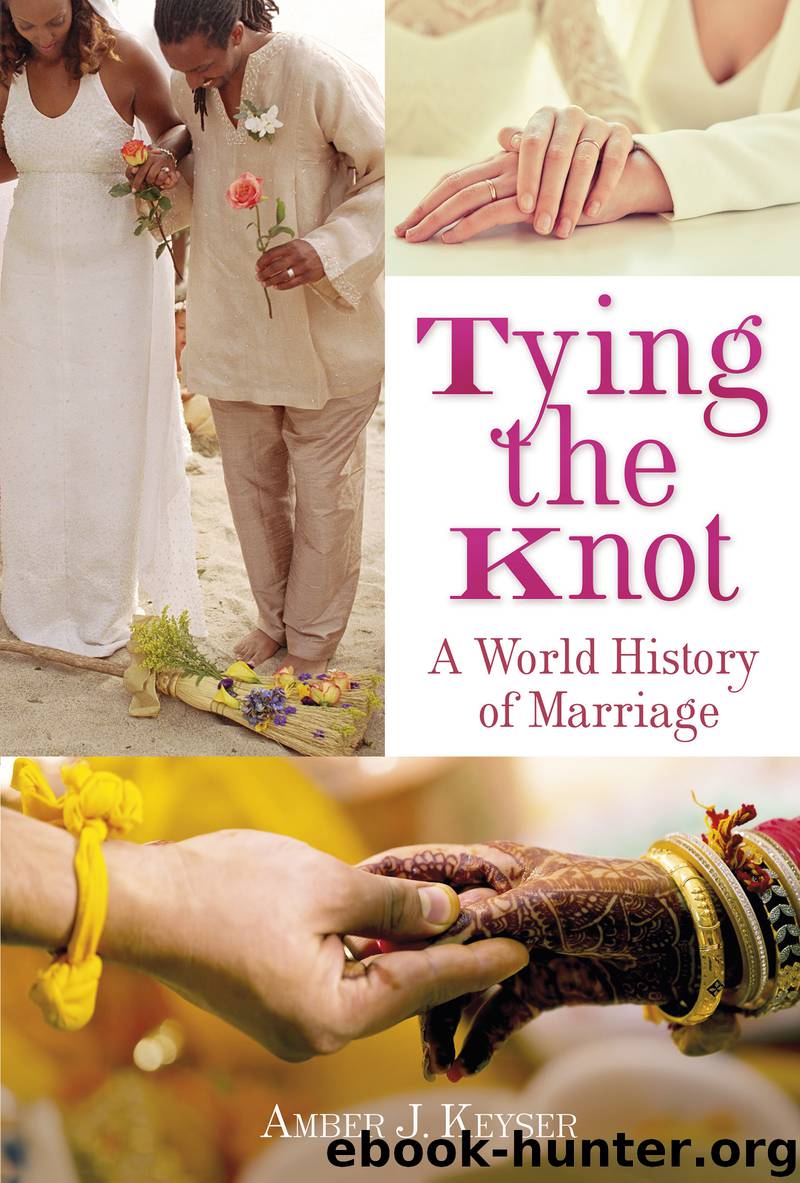Tying the Knot by Amber J. Keyser

Author:Amber J. Keyser [Keyser, Amber J.]
Language: eng
Format: epub
Tags: Nonfiction, Young Adult Nonfiction, Young Adults, A World History of Marriage, Africa, Amber J. Keyser, America, Ancient History, arranged marriage, Buddhism, Catholic Church, Ceremonies, China, Christianity, Church of England, Civil Rights, Cultural Tradition, Cultural Traditions, Culture, Customs, Divorce, Engagement, Engagements, Equality, Equality in Marriage, Europe, Hinduism, History, History & Customs, History & Government, History of Marriage, Homosexuality, India, Islam, Islamic, Japan, Jewish Customs, Judaism, Loveless marriage, Marriage, Marriage & Divorce, Marriage Equality, Marriages, Multicultural, Muslim, Muslims, Patriarchy, People & Places, People and Plants, Religion, Religious Culture, Religious Cultures, Religious Tradition, Romanticism, Same-Sex Marriage, Sexism, Social Issues, Social Life and Customs, Social Studies, Tradition, Traditions, Twenty First Century Books, Twenty-First Century Books, Tying the Knot, Tying the Knot: A World History of Marriage, Wedding, Weddings, Women's Rights, Women's Rights Movement
ISBN: 9781541522046
Publisher: Lerner Publishing Group
Published: 2018-01-01T05:00:00+00:00
In this photo from 2014, a man holds a teenage girl in Kenya as she struggles to break free. She has just learned that she is to be married to a man she doesn’t know in a distant town. Her family arranged the marriage, and the groom provided a bride-price of twenty goats, three camels, and ten cows.
For child brides, the dangers and the repercussions are serious. Many experience violence and abuse at the hands of their husbands. And early marriage means the end of education and the beginning of decades of childbirth and motherhood. Around the world, every hour, girls between the ages of fifteen and nineteen give birth to about sixteen hundred babies. Pregnancy and childbirth are the leading causes of death for girls in this age range. They die because they live mostly in poor nations, where prenatal care is often nonexistent or inadequate. Birthing facilities are barebones and unsanitary. Many girls are already in poor health—suffering from HIV/AIDS or undernourishment—when they become pregnant. Without education and health care, these teen mothers and their children are trapped in poverty. The likelihood of making a better life is extremely low. The United Nations (UN)—an international humanitarian and peacekeeping organization—considers the forced marriage of girls and women to be a form of slavery. The UN works with global nonprofit organizations to address the poverty and social conventions that lead to forced marriage.
“No Toilet, No Bride”
In rural India, a public health campaign launched in 2007 links marriage with improved sanitation. More than 665 million people in India lack indoor toilets or private outhouses. Their only option is to relieve themselves in fields or waterways near their homes. To avoid sexual assault, many women wake up before dawn so they can relieve themselves outdoors under the cover of darkness. Unsanitary conditions like this lead to horrific rates of deadly diarrhea-related diseases. To promote safety and hygiene, the Indian government’s No Toilet, No Bride campaign urges parents of brides to insist that potential husbands provide their daughters with a living space that includes a bathroom. The government advertises the campaign with a popular radio jingle: “No loo [toilet]? No ‘I do!’ ” In the first two years of the campaign, Indian families built a total of 1.4 million toilets.
Download
This site does not store any files on its server. We only index and link to content provided by other sites. Please contact the content providers to delete copyright contents if any and email us, we'll remove relevant links or contents immediately.
Pale Blue Dot by Carl Sagan(4618)
Cracking the GRE Premium Edition with 6 Practice Tests, 2015 (Graduate School Test Preparation) by Princeton Review(4047)
Pocahontas by Joseph Bruchac(4028)
Unfiltered by Lily Collins(3910)
The Emotionary: A Dictionary of Words That Don't Exist for Feelings That Do by Eden Sher(3221)
The Daily Stoic by Holiday Ryan & Hanselman Stephen(3110)
Factfulness_Ten Reasons We're Wrong About the World_and Why Things Are Better Than You Think by Hans Rosling(3046)
The President Has Been Shot!": The Assassination of John F. Kennedy by Swanson James L(2972)
Sapiens and Homo Deus by Yuval Noah Harari(2843)
Rogue Trader by Leeson Nick(2825)
The 48 laws of power by Robert Greene & Joost Elffers(2808)
The Rape Of Nanking by Iris Chang(2650)
Almost Adulting by Arden Rose(2585)
Gettysburg by Iain C. Martin(2575)
The Innovators: How a Group of Hackers, Geniuses, and Geeks Created the Digital Revolution by Walter Isaacson(2497)
500 Must-Know AP Microeconomics/Macroeconomics Questions(2476)
The Plant Paradox by Dr. Steven R. Gundry M.D(2427)
In the Woods by Tana French(2413)
Make by Mike Westerfield(2202)
